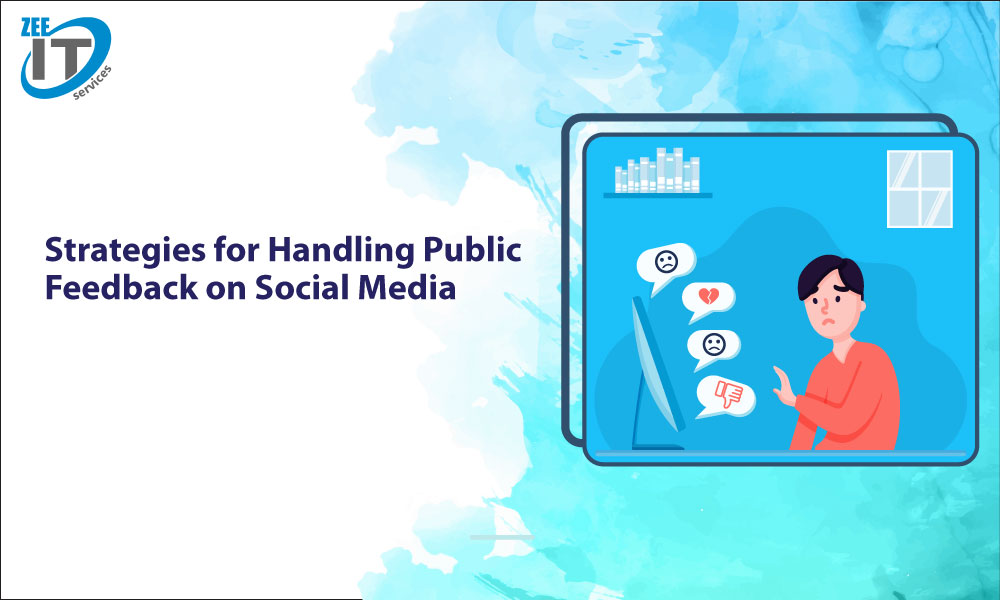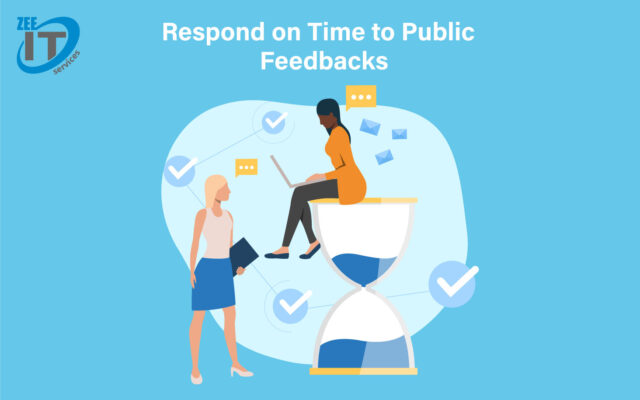In the age of social media, we can’t neglect the importance of comments and reviews. We do the marketing of our products mostly through social media channels. They directly influence the sales of your brand. Even whenever I want to buy something online, I must read the reviews of those people who have already used it. and after reading those reviews, I made the decision to buy it. people make different comments including positive and negative. Why are negative comments bad? Your brand reputation is influenced by the negative feedback. Receiving these comments is unavoidable, but here the important thing to consider is how you handle them. Poor handling can hurt you and your brand and turn customers away.
That’s why we take this guide for you in which we’ll reveal some strategies for handling public feedback on social media. So, let’s start it!
Why is public feedback important?
Before delving into strategies for managing public feedback, it’s crucial to recognize the significance of this aspect of social media engagement. Public feedback serves as a direct channel for customers to express their opinions, experiences, and concerns regarding a brand or its products/services. We can analyze the importance of feedback from this fact which shows that 94% of consumers agree that bad reviews convince them to leave a business. public feedback holds immense power, influencing brand reputation, customer perceptions, and purchase decisions. By actively engaging with public feedback, businesses can demonstrate their commitment to customer satisfaction and build trust within their online community.
Believe in addressing the bad comments:
Most of the people here prefer to delete negative comments and think that this is the easiest solution to get rid of this bad feedback but have you ever thought that this is not a solution?
Comments tell you about the sentiments of your followers and what they actually think about your brand. Even positive or negative both comments help you to improve your brand.
Each comment is important for your brand so must believe in addressing each comment. The best practice for bad comments is to address them quickly, be apologetic, and then try to take them off the public-facing areas to discuss them privately.
In this way, your audience thinks that you’re dealing with any issues, and the details will remain private. Always getting positive ratings also doubted the people so sometimes negative comments also help your brand to be more realistic. It also shows that you don’t have anything to hide and are transparent in your services. But again It all depends on how you deal with the comments.
How to deal with different types of negative comments?
Establishing clear guidelines for responding to different types of negative comments on social media is crucial for maintaining a positive online presence and effectively managing customer relationships. By defining specific protocols and providing templated responses, your team can ensure consistency, professionalism, and promptness in addressing incoming notifications and messages. Here’s a comprehensive approach to creating standards for your social media communications:
- Begin by identifying the most common types of negative comments your brand receives on social media. These may include complaints about product quality, customer service issues, shipping delays, or general dissatisfaction.
- Create response templates tailored to each type of negative comment identified. These templates should be on-brand, empathetic, and solution-oriented. Consider including elements such as Acknowledgment of the issue, Apology for any inconvenience caused, Assurance of prompt resolution, Invitation to take the conversation offline for further assistance
- Establish clear response timeframes for addressing negative comments based on their severity and urgency. For example: for more critical issues consider responding in 1 hour, for moderate issues respond within 4 hours and for low-priority issues respond within 24 hours.
- Then after that must ensure that your social media team is adequately trained on the established response protocols and templates. Provide guidance on tone, language, and demeanor when engaging with customers online.
- As your brand evolves and new challenges arise, update your social media communications guidelines accordingly. Stay agile and adaptable to ensure that your team remains equipped to handle any situation effectively.
Respond on time:
Time is the essence when it comes to addressing customer concerns in the digital age. Responding promptly to negative comments on social media is imperative for maintaining positive customer relationships and preserving your brand’s reputation. Here’s why responding on time is crucial:
- When you respond timely to negative comments it shows that your brand values customer feedback and is committed to addressing issues promptly. It reassures customers that their concerns are being heard and taken seriously, fostering trust and loyalty.
- When you ignore negative feedback, it might worsen the issue and make your client even more angry or frustrated. You can keep problems from growing into bigger ones and maybe harming the reputation of your company by taking prompt action.
- Your commitment to offering first-rate customer service is evident in your prompt answers to unfavorable reviews. Quick problem-solving allows you to transform bad experiences into good ones, making clients happy with the result and more inclined to stick with your company.
- News spreads quickly in the connected world of today, particularly on social media sites. A delayed response to negative remarks might convey to consumers—both current and new—that your company is unaware or ignorant, damaging its reputation.
- Social media makes it possible for clients to communicate with one another from all over the world and in different time zones, which makes quick replies even more important. You can make sure that clients from different geographic places feel appreciated and supported by keeping a quick response time.
- Getting back to clients quickly when they have negative feedback is a good way to start future encounters. It emphasizes your brand’s dedication to providing outstanding customer service and sets expectations for quick responses.
Approach negative comments with facts and not emotions
In order to manage online criticism efficiently and protect your brand’s reputation, you must respond to unfavorable comments in a factual and non-emotional manner. Knowing the difference between genuine concerns and provocative comments is crucial when determining whether or not to participate. Providing accurate responses to criticism shows professionalism and authority. Customers will view your brand as more transparent and reliable if you respond to their complaints with factual information and supporting data.
Acknowledging when your brand is at fault and offering sincere apologies and solutions can help resolve customer grievances effectively. By addressing concerns head-on and providing solutions, you demonstrate your commitment to customer satisfaction and willingness to rectify any mistakes. Then after that in some cases where negative comments are based on misinformation or misunderstanding, responding with factual information can help clarify the situation and correct any inaccuracies. By presenting the facts in a clear and concise manner, you can mitigate the spread of false information and prevent further misunderstandings.
Engaging with inflammatory remarks or trolls can escalate tensions and lead to a negative spiral of online interactions. By refraining from responding to provocations and inflammatory comments, you can avoid fueling the fire and maintain a positive online environment.
Give careful consideration to answering criticism when genuine concerns are raised. Resolving these issues truthfully and quickly shows that you care about your clients’ experiences and can help make bad ones better. Under some circumstances, it could be better to ignore provocative or offensive words. Reacting to such remarks frequently backfires and provides the instigator with the attention they desire. Rather, concentrate on interacting with sincere concerns and helpful criticism.
Always report harassment
Reporting harassment is crucial for maintaining a safe and respectful online environment for you, your followers, and your community. It’s essential to distinguish between constructive criticism and outright harassment and take appropriate action when necessary. Here’s what steps you can take to address it effectively:
- Harassment, whether it’s directed at you or your followers, can have serious consequences for mental health and well-being. Reporting harassment helps ensure the safety and security of everyone involved and creates a supportive online community free from abusive behavior.
- Major social media platforms such as Facebook, Twitter, and Instagram have policies in place to address abusive behavior and harassment. By familiarizing yourself with these policies, you can understand what constitutes harassment and take the necessary steps to report it.
- If you or your followers experience harassment on social media, don’t hesitate to report it to the respective platform. Most platforms provide options to report abusive behavior, including harassment, threats, and hate speech. Taking immediate action can prevent further harm and signal to others that such behavior will not be tolerated.
- In addition to reporting harassment, consider blocking accounts that engage in abusive behavior. Blocking prevents further interactions with the harasser and protects you and your followers from further harm. Additionally, document instances of harassment and provide evidence to your legal team and community for awareness and potential action.
- By actively addressing harassment and abusive behavior, you create a safer and more welcoming environment for your audience. Encourage open communication and support among community members, and take a zero-tolerance approach to harassment and bullying.
- If you’re unsure how to handle harassment or need assistance, don’t hesitate to seek support from trusted friends, colleagues, or legal professionals. They can provide guidance and assistance in navigating the reporting process and addressing the situation effectively.
Frequently Asked Questions
Why is handling public feedback on social media important?
Public feedback on social media can impact brand reputation, customer satisfaction, and purchase decisions. Effectively managing it is crucial for maintaining a positive online presence.
What are the key components of effective public feedback management?
Transparency, responsiveness, empathy, and professionalism are essential components. Acknowledging feedback, addressing concerns promptly, and offering solutions are key strategies.
How should I respond to negative comments or feedback?
Respond with empathy and professionalism, acknowledge the issue, offer a sincere apology, and provide a resolution. Avoid becoming defensive and address the concern promptly.
Should I respond to all types of feedback, including trolls or inflammatory remarks?
It’s essential to differentiate between genuine concerns and inflammatory remarks. Respond to genuine concerns promptly, but consider ignoring trolls or inflammatory comments to prevent escalation.
How can I leverage positive feedback to enhance brand perception?
Showcase positive reviews and testimonials on social media, website, or marketing materials. Engage with customers who provide positive feedback to amplify their satisfaction and build credibility.


